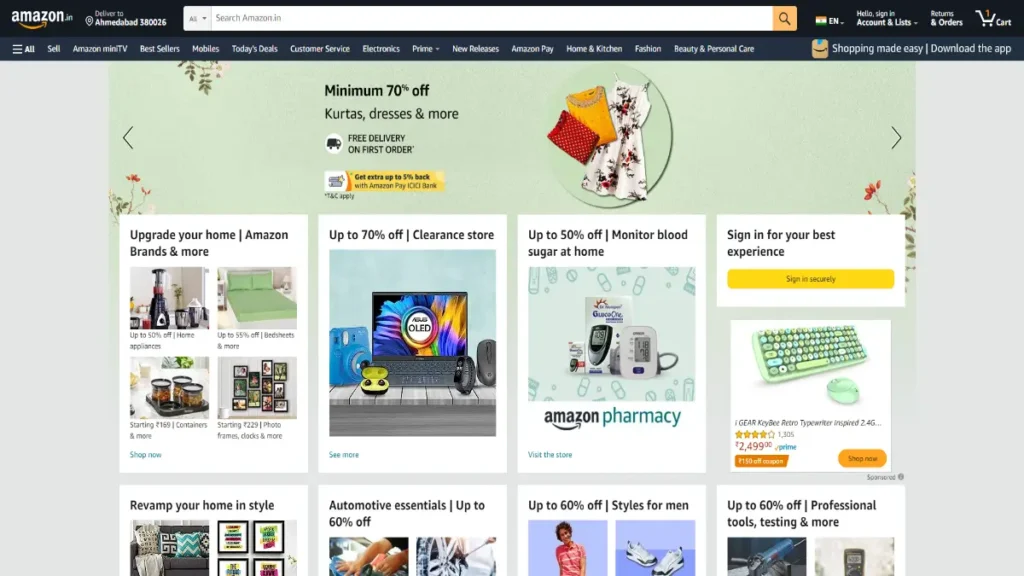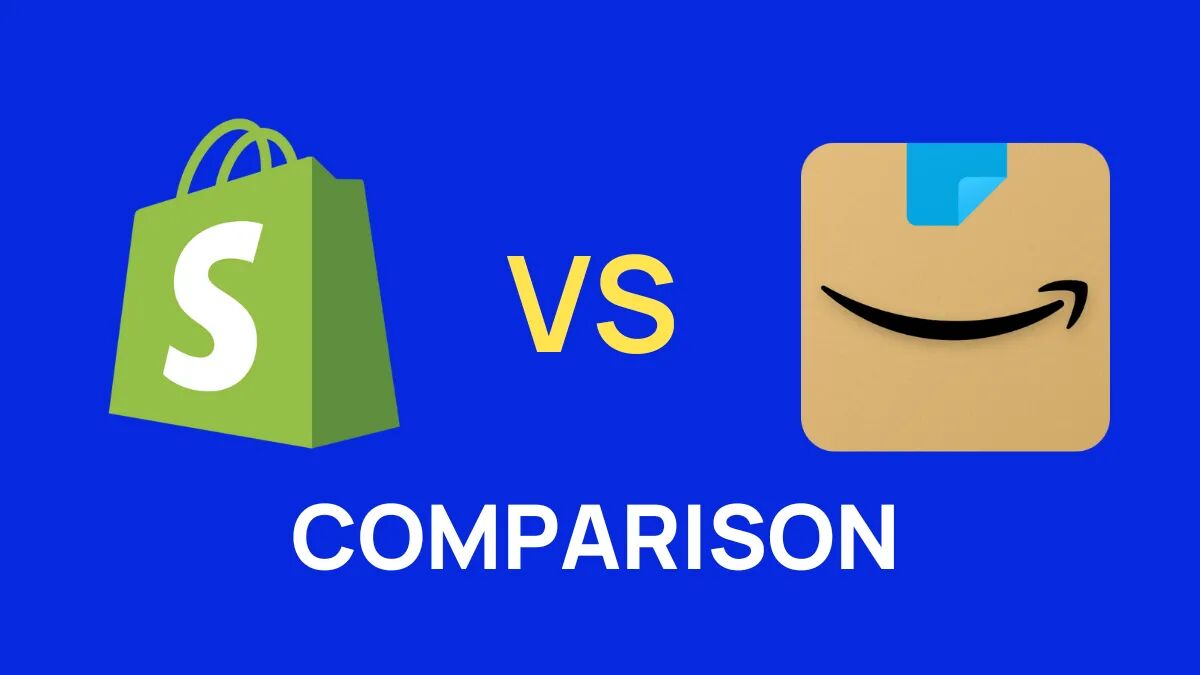Are you looking to sell products online but unsure which e-commerce platform to choose Shopify vs Amazon? In this article, we will compare two popular options: Shopify and Amazon. By the end, you should have a clearer idea of which platform suits your needs better.
Save Time By Reading “Comparison Chart Of Shopify Vs Amazon“
Table of Contents
Overview of Shopify and Amazon
Shopify

Shopify is an e-commerce platform that allows users to create online stores, manage inventory, process orders, and accept payments. It has a user-friendly interface and offers a wide range of customization options, including themes, apps, and plugins.
Amazon

Amazon is a global online marketplace that connects buyers and sellers. It offers various seller programs, including Individual, Professional, and Enterprise plans. Sellers can list products, manage orders, and access fulfillment services, among other features.
Pricing and Fees
Shopify
Shopify offers three main pricing plans: Basic, Shopify, and Advanced Shopify. Prices range from $29 to $299 per month, depending on the plan and features. Shopify also charges transaction fees for payments made through third-party gateways, such as PayPal or Stripe.
Amazon
Amazon offers different seller programs with different fees and features. The Individual plan charges $0.99 per item sold, plus referral fees ranging from 6% to 45% depending on the product category. The Professional plan charges a monthly subscription fee of $39.99 but waives the per-item fee and reduces the referral fees. The Enterprise plan is designed for high-volume sellers and offers additional benefits, such as dedicated account management and custom pricing.
Also Read: How to sell on Amazon
Features and Flexibility
Shopify
Shopify offers a wide range of features for e-commerce, including:
- Customizable storefront design with themes and templates
- App store with over 4,000 apps and plugins for various functionalities
- Product management with options for variants, images, descriptions, and SKUs
- Order processing with integration to various shipping carriers and fulfillment services
- Payment processing with multiple gateways and options for fraud prevention
- Marketing tools with options for SEO, social media, email, and discounts
- Analytics and reporting with insights on sales, traffic, and customer behavior
Shopify also allows users to sell on multiple channels, such as Facebook, Instagram, Amazon, and eBay. Read Shopify Review here.
Amazon
Amazon offers a simpler but more centralized approach to selling, including:
- Product listing with options for variations, descriptions, and images
- Order management with integration to Amazon’s fulfillment services (FBA)
- Payment processing with options for a credit card, gift card, and Amazon Pay
- Marketing tools with options for sponsored products and deals
- Analytics and reporting with insights on sales and traffic
Amazon also offers a global customer base and access to Prime members, who are more likely to buy and receive free shipping. Read Amazon FAQ here.
Support and Resources
Shopify
Shopify offers various resources and support options, including:
- 24/7 customer support via chat, email, and phone
- Help center with articles, guides, and videos
- Community forum with discussions and feedback
- Academy with courses and certifications
- Experts marketplace with verified professionals for design, development, and marketing
Amazon
Amazon offers different support options depending on the seller program, including:
- Seller central with help pages, FAQs, and tutorials
- Seller university with courses and webinars
- Seller support with email and phone support
- Account managers for Enterprise sellers
Here is a more comprehensive comparison chart that includes additional factors beyond just pricing, features, and support:
| Aspect | Shopify | Amazon |
|---|---|---|
| Overview | E-commerce platform for creating online stores, managing inventory, processing orders, and accepting payments | Global online marketplace that connects buyers and sellers |
| Ease of Use | User-friendly interface with drag-and-drop functionality, easy customization options through themes and apps | Easy setup process with step-by-step guidance, simple product listing process |
| Pricing | Plans range from $29 to $299 per month, transaction fees for payments made through third-party gateways | Customizable storefront design, an app store with 4,000+ apps/plugins, product management with options for variants/images/descriptions/SKUs, order processing with integration to various shipping carriers and fulfillment services, payment processing with multiple gateways and options for fraud prevention, marketing tools with options for SEO/social media/email/discounts, analytics and reporting with insights on sales/traffic/customer behavior, ability to sell on multiple channels |
| Features | Depending on marketing efforts, the customer base may be smaller and more niche but may also be more loyal, repeat customers | Product listing with options for variations, descriptions, and images, order management with integration to Amazon’s fulfillment services (FBA), payment processing with options for credit card/gift card/Amazon Pay, marketing tools with options for sponsored products and deals, analytics and reporting with insights on sales and traffic |
| Flexibility | Multiple payment gateways are available, including Shopify Payments, PayPal, Stripe, Amazon Pay, and others | Limited customization options, restricted branding options, limited ability to sell on other channels outside of Amazon |
| Customer Base | 24/7 customer support via chat/email/phone, help center with articles/guides/videos, community forum, an academy with courses/certifications, experts marketplace | Large global customer base with access to Prime members who are more likely to buy and receive free shipping |
| Support | Wide range of customization options, ability to integrate with third-party apps and plugins, the option to use your own domain name, ability to sell on multiple channels including Facebook/Instagram/Amazon/eBay | Seller central with help pages/FAQs/tutorials, seller university with courses/webinars, seller support with email/phone support, account managers for Enterprise sellers |
| Shipping and Fulfillment | Option to integrate with various shipping carriers and fulfillment services, ability to offer custom shipping rates and options | Integration with Amazon’s fulfillment services (FBA), ability to offer Prime shipping, limited ability to offer custom shipping rates and options |
| Branding | Full control over branding and design, option to use your own domain name | Limited branding options, Amazon branding is prominent on product listings and in communications with customers |
| Fraud Prevention | Multiple options for fraud prevention, such as Shopify Payments, Shopify Fraud Protect, and third-party fraud prevention apps and plugins | Limited fraud prevention options, rely on Amazon’s fraud detection measures |
| Payment Options | Option to access Shopify’s API for custom development, extensive documentation, and resources available | Limited payment options, primarily credit card/gift card/Amazon Pay |
| Returns | Option to set up a custom return policy, ability to manage returns through the Shopify platform | Returns managed through Amazon’s system, may be subject to Amazon’s own return policies and fees |
| Sales Tax | Option to automatically calculate and collect sales tax based on location, integration with various tax calculation apps and plugins | Automatic sales tax calculation and collection in certain states, integration with various tax calculation apps and plugins |
| Inventory Management | Option to manage inventory through Shopify’s platform, automated low stock notifications and purchase order creation, integration with various inventory management apps and plugins | Inventory management tools available, including FBA inventory management, limited integration with third-party inventory management systems |
| Option to manage inventory through Shopify’s platform, automated low stock notifications, and purchase order creation, integration with various inventory management apps and plugins | Option to access Shopify’s API for custom development, extensive documentation and resources available | Limited options for custom development, must adhere to Amazon’s guidelines and policies |
| Advertising | Option to run advertising campaigns through the Shopify platform, integration with Facebook/Google Ads, ability to track ad performance through analytics and reporting | Advertising options available through Amazon’s platform, including sponsored products and deals, limited ability to track ad performance outside of Amazon |
| Market Saturation | Growing in popularity but not as widely used as Amazon | Highly competitive marketplace with many sellers and product offerings |
Also Read: Shopify FAQ: most asked question answered
Conclusion
Both Shopify and Amazon have their strengths and weaknesses, and the choice depends on various factors, such as:
- Your business size and goals
- Your product types and categories
- Your target audience and location
- Your budget and resources
In general, Shopify is more flexible and customizable, while Amazon is more centralized and established. If you are a small or medium-sized business with unique branding and product offerings, Shopify may be a better fit. If you are a large-scale seller with a wide range of products and a focus on reach and visibility, Amazon may be a better fit.
Overall, both platforms offer valuable options for e-commerce, and it’s important to weigh your options carefully before making a decision. Whichever platform you choose “Shopify vs amazon”, remember that quality content, user experience, and search engine optimization (SEO) are crucial for success.
By creating high-quality content that resonates with your target audience, optimizing your website for search engines, and providing excellent customer support, you can outrank competitors and achieve your e-commerce goals.
Also, Visit: Ecommerce Platforms Hub To Know More
People Also Ask “Shopify Vs Amazon”
What are the differences between Shopify and Amazon?
Shopify is a platform that allows individuals and businesses to create their online stores and sell products, while Amazon is an online marketplace that enables individuals and businesses to sell their products directly to consumers. Unlike Amazon, Shopify offers a more personalized and customizable online store experience for merchants, with features such as custom domains, advanced analytics, and more control over the design of the store.
Which platform is better for small businesses, Shopify Vs Amazon?
While both platforms offer benefits for small businesses, Shopify may be a better option for those looking to establish their own brand identity and control over their online store. Shopify offers more customization options and allows for greater control over the look and feel of the store. Amazon, on the other hand, has a larger customer base and can provide greater exposure and potential sales for small businesses. Ultimately, the best platform for a small business will depend on its individual needs and goals.
Can I use both Shopify and Amazon to sell my products?
Yes, many merchants use both platforms to sell their products. By using Shopify and Amazon together, businesses can reach a larger customer base and take advantage of the benefits of both platforms. For example, a business could use Shopify to establish its own brand identity and control over its online store, while also using Amazon to reach a larger audience and take advantage of Amazon’s customer base.
Which platform has better customer support, Shopify Vs Amazon?
Both Shopify and Amazon offer customer support to their users, but the level of support may differ. Shopify offers 24/7 support via phone, email, and live chat, while Amazon provides support through email and phone. Shopify also offers a robust knowledge base and community forum for users to find answers to common questions.
What are the fees associated with selling on Shopify vs Amazon?
Both platforms charge fees for selling products. Shopify charges a monthly fee for access to their platform, with additional fees for transaction processing and other features. Amazon charges a referral fee and a variable closing fee on each item sold, in addition to other fees such as storage fees and fulfillment fees for using their fulfillment services. The fees associated with each platform will depend on the individual needs of the business and the products being sold.
